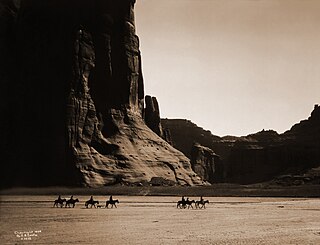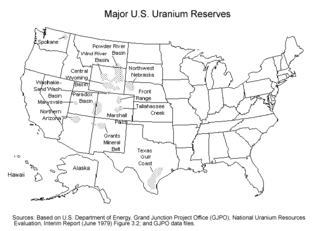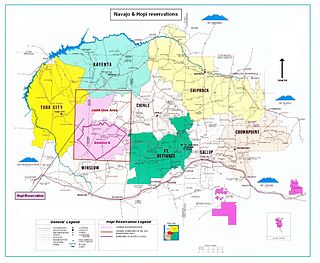
Church Rock is a census-designated place (CDP) in McKinley County, New Mexico, United States. The population was 1,542 at the 2020 census, up from 1,128 in 2010. The community is named for Church Rock, a prominent natural landmark.

The Navajo Nation, also known as Navajoland, is an Indian reservation of Navajo people in the United States. It occupies portions of northeastern Arizona, northwestern New Mexico, and southeastern Utah. The seat of government is located in Window Rock, Arizona.

An American Indian reservation is an area of land held and governed by a U.S. federal government-recognized Native American tribal nation, whose government is autonomous, subject to regulations passed by the United States Congress and administered by the United States Bureau of Indian Affairs, and not to the U.S. state government in which it is located. Some of the country's 574 federally recognized tribes govern more than one of the 326 Indian reservations in the United States, while some share reservations, and others have no reservation at all. Historical piecemeal land allocations under the Dawes Act facilitated sales to non–Native Americans, resulting in some reservations becoming severely fragmented, with pieces of tribal and privately held land being treated as separate enclaves. This intersection of private and public real estate creates significant administrative, political, and legal difficulties.

Diné College is a public tribal land-grant college based in Tsaile, Arizona, serving the 27,000-square-mile (70,000 km2) Navajo Nation. It offers associate degrees, bachelor's degrees, academic certificates, and one master's degree.

Canyon de Chelly National Monument was established on April 1, 1931, as a unit of the National Park Service. Located in northeastern Arizona, it is within the boundaries of the Navajo Nation and lies in the Four Corners region. Reflecting one of the longest continuously inhabited landscapes of North America, it preserves ruins of the indigenous tribes that lived in the area, from the Ancestral Puebloans to the Navajo. The monument covers 83,840 acres and encompasses the floors and rims of the three major canyons: de Chelly, del Muerto, and Monument. These canyons were cut by streams with headwaters in the Chuska Mountains just to the east of the monument. None of the land is federally owned. Canyon de Chelly is one of the most visited national monuments in the United States.
Uranium in the environment is a global health concern, and comes from both natural and man-made sources. Beyond naturally occurring uranium, mining, phosphates in agriculture, weapons manufacturing, and nuclear power are anthropogenic sources of uranium in the environment.

Uranium mining in the United States produced 224,331 pounds (101.8 tonnes) of U3O8 in 2023, 15% of the 2018 production of 1,447,945 pounds (656.8 tonnes) of U3O8. The 2023 production represents 0.4% of the uranium fuel requirements of the US's nuclear power reactors for the year. Production came from five in-situ leaching plants, four in Wyoming (Nichols Ranch ISR Project, Lance Project, Lost Creek Project, and Smith Ranch-Highland Operation) and one in Nebraska (Crowe Butte Operation); and from the White Mesa conventional mill in Utah.

Uranium mining in Arizona has taken place since 1918. Prior to the uranium boom of the late 1940s, uranium in Arizona was a byproduct of vanadium mining of the mineral carnotite.
Lawrence T. Morgan is the former Speaker of the Navajo Nation Tribal Council.
Canada has an active anti-nuclear movement, which includes major campaigning organisations like Greenpeace and the Sierra Club. Over 300 public interest groups across Canada have endorsed the mandate of the Campaign for Nuclear Phaseout (CNP). Some environmental organisations such as Energy Probe, the Pembina Institute and the Canadian Coalition for Nuclear Responsibility (CCNR) are reported to have developed considerable expertise on nuclear power and energy issues. There is also a long-standing tradition of indigenous opposition to uranium mining.
Uranium mining in New Mexico was a significant industry from the early 1950s until the early 1980s. Although New Mexico has the second largest identified uranium ore reserves of any state in the United States, no uranium ore has been mined in New Mexico since 1998.

The Return of Navajo Boy is a documentary film produced by Jeff Spitz and Bennie Klain about the Cly family, Navajo who live on their reservation. Through them, the film explores several longstanding issues among the Navajo and their relations with the United States government and corporations: environmental racism, media and political representation, off-reservation adoption, and denial of reparations for environmental illnesses due to uranium mining in Monument Valley, Utah, which was unregulated for decades. Bill Kennedy served as the film's executive producer; his late father had produced and directed the earlier silent film The Navajo Boy (1950s), which featured the Cly family.

The Church Rock uranium mill spill occurred in the U.S. state of New Mexico on July 16, 1979, when United Nuclear Corporation's tailings disposal pond at its uranium mill in Church Rock breached its dam. The spill remains the largest release of radioactive material in U.S. history, having released more radioactivity than the Three Mile Island accident four months earlier.

The relationship between uranium mining and the Navajo people began in 1944 in northeastern Arizona, northwestern New Mexico, and southeastern Utah.

Erigeron rhizomatus is a rare species of flowering plant in the family Asteraceae known by the common names Zuni fleabane and rhizome fleabane. It is native to western New Mexico and eastern Arizona in the United States. It is a federally listed threatened species.

The Bennett Freeze was a 43-year development ban on 1.5 million acres of Navajo lands by the US Federal Government. It was put in place in 1966 in order to promote negotiations over a land dispute between the Navajo and the Hopi and lasted until 2009. It was named for the Commissioner of Indian Affairs at the time, Robert L Bennett, and meant that in the "frozen" area, no development at all could occur. This included fixing roofs, building houses, constructing gas and water lines, and repairing roads.
The World Uranium Hearing was held in Salzburg, Austria in September 1992.Anti-nuclear speakers from all continents, including indigenous speakers and scientists, testified to the health and environmental problems of uranium mining and processing, nuclear power, nuclear weapons, nuclear tests, and radioactive waste disposal.
The Navajo Uranium Assessment and Kidney Health Project (NUAKHP) was a congressionally mandated study conducted by researchers from the University of New Mexico and Crownpoint IHS Hospital on kidney functions of Navajo Native Americans who lived and worked near decommissioned uranium mines. The long-term goal of the five-year project beginning in 2006, was to use the studies results to develop a kidney health registry to inform concerned people about possible risks of local drinking water.

Diné CARE is a Diné (Navajo) activist organization that works on environmental, cultural and social justice campaigns, primarily within the Navajo Nation and the immediately surrounding areas, its main office being in Dilkon, AZ. Diné CARE stands for Diné Citizens Against Ruining Our Environment and helped build the early environmental justice movement in the United States. Their work has included opposing the creation of toxic waste infrastructure, polluting energy infrastructure, industrial-scale logging, advocating for compensation for people impacted by uranium mining and weapons development as well as against business practices that facilitate abuse of alcohol in nearby Gallup. The organization held a campaign to facilitate Native voter turnout during the presidential election of 2020.

Lori Goodman is a Native American environmentalist from Dilkon, Arizona. Goodman was one the founding members of Diné CARE that was founded in 1989 and is currently retired as an executive director.














